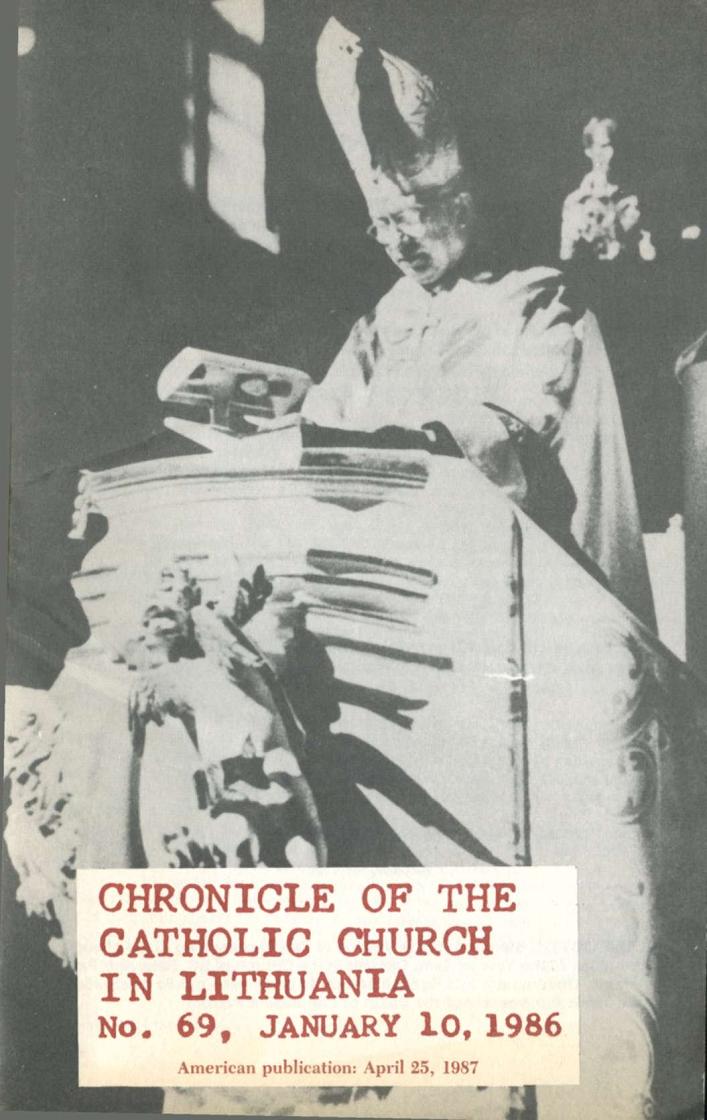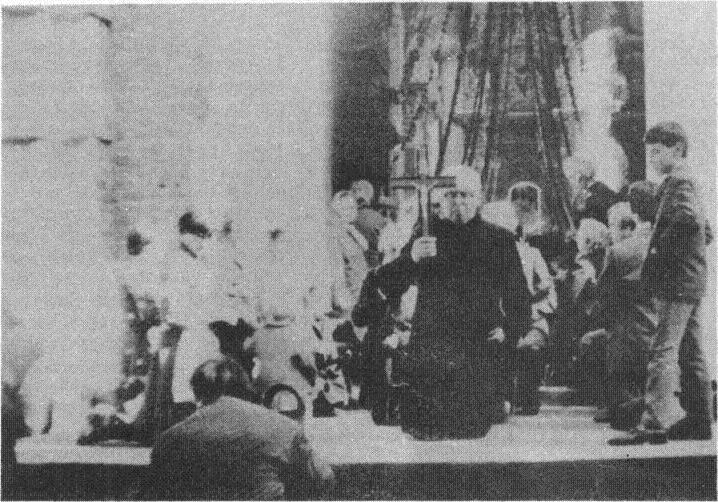
Appearing since 1972!
Read this and pass i t on!
If you can, reproduce i t!
CHRONICLE OF THE CATHOLIC CHURCH IN LITHUANIA, No. 69 
In this issue:
2. Petras Anilionis "Instructs" Priests-to-Be
3. A Reader's Letter to the Chronicle
4. When Will the Desecration of Churches Cease?
7. From the Chronicle Archives
9. New Underground Publications
Lithuania January 10, 1986
The faithful of Lithuania are insulted and pained by the constantly increasing number of Lithuanian clergy participating in the so-called Peace Conference in Berlin and other conferences similar to it -- even the celebration of the Victory of Moscow.
If those participating in this "peace" game were immature youths products of the Communist Youth League -- it would be possible to smile sadly and remain silent. Now it is impossible to remain silent, since the priests' so-called struggle for peace is nothing other than sheer hypocrisy and betrayal of the Catholic Church.
If these clergymen were really concerned about peace, they would look at this problem through the eyes of their own Catholic Church.
However, not one of these "fighters" or "peacemakers", as the people aptly characterize them, has shown any interest in the position of the Catholic Church on the question of peace.
The latter is set forth clearly enough in the encyclical, Redemptor hominis, par. 17 (6-p. 52-58). Every priest should inscribe deeply in his heart the encyclical's words - "At the basis of peace is respect for inviolable human rights; for peace is justice and war arises from infringement of those rights."
At the end of October, 1985, the repeatedly postponed traditional seminarians' meeting at the beginning of the academic year with the Commissioner for Religious Affairs Petras Anilionis took place. In his talk, AniIionis set forth the important manifestations of "religious extremism" in the activities of the Catholic Church in Lithuania.
In the beginning, he touched purely on the internal affairs of the Church: last year's elections of the priests' councils. Anilionis, contrary to Canon Law, affirmed that the Bishops' Conference has the right to impose a standard set of rules on the priests' councils of all dioceses. Msgr. Kazimieras Dulksnys, Administrator of the Diocese of Panevėžys, and Father Donatas Valiukonis, Consul tor of the Archdiocese of Vilnius, were publicly assailed for their objection to the uncanonical interference of the civil government in the makeup of priests' councils and colleges of consultors.
Msgr. Dulksnys was criticized for not restraining priests when they show some energy in the war against atheism, while immediately reacting when suspicion falls on priests in the moral sphere. This allegedly is the influence of the extremists, and such behavior on the part of the administrator, according to Anilionis, is an embarassment for the Catholic Church.
(Painful Anniversaries)
One greets each New Year with certain hopes, expectations and wishes. One wishes and trusts that the coming year will be better and more meaningful. Even among the customs of barely developed nations, various New Year's ceremonies prevail, with the help of which an attempt is made to ward off misfortune and evil spirits. No shadows are supposed to darken New Year's happiness.
Alas, 1986 brings the faithful of Lithuania not only happiness and a joyful, uplifting spirit, but also reminds them of one more painful anniversary on January 26, which we shall mark among many: It will be the third anniversary of Father Alfonsas Svarinskas' incarceration.
Three years are a very brief period in a person's life. However, it looks much different when these three years constitute the continuation of nineteen years of confinement. Of thirty-one years of Father Alfonsas Svarinskas' priesthood, eleven have been spent behind bars and barbed wire without the right to call himself not only a priest, but even a human being! He is a clerical extremist and calumniator, a dangerous criminal and the paid lackey of bourgeois ideology, a troublemaker and who knows what else; only not a priest, not a human being defending the truth, struggling for the affairs of God, and for the ideals of spiritual improvement.
Lately, burglaries of churches have grown more frequent. In Kaunas alone this fall, the churches of Saint Anthony and Panemunė were burglarized; burglaries occurred in the churches of Dūkštas, Švenčionėliai and Braziūkai. An attempt was made to burglarize the church of Šančiai, but the culprits were caught at the scene of the crime.
It is difficult to know what barometer these waves of sacrilege follow. But one thing is clear: These are not exceptions or anomalies, but part of a criminal chain. What is it: Satanism, the recreation of bored macho young men or consciously malicious activity? If the first two causes predominate, then it would not be very difficult to abolish them. It would be enough for the forces of law and order to crack down, and order would be restored. But the organs of the militia do not look for this type of criminal very seriously, and the courts let them off easily, so it is with some reason that one comes to the entirely logical conclusion that in this case, it is the third cause which holds, namely, consciously malicious activity.
Lithuania's Praying
Žemaičių Kalvarija (Varduva, Plunge Rayon)
The great religious festival of Žemaičių Kalvarija (beginning July 2), was celebrated with great enthusiasm and devotion, in spite of constant government interference: checking of public transportation, registration of private automobiles, strict monitoring of people at work, etc.
Pivašiūnai (Alytus Rayon)
On August 11, 1985, the militia kept stopping people traveling to the religious festival of the Assumption celebrated in Pivašiūnai. That day, they allowed no one to drive into town, rerouting automobiles out into the fields. On the streets and in the churchyard, KGB agents icily scrutinized everyone going to church. The church and churchyard were full of worshippers. His Excellency, Bishop Vincentas Sladkevičius also came to the devotions. The bishop concelebrated Holy Mass together with visiting priests, and preached the sermon, during which he emphasized the significance of Mary in our lives and her maternal protection, urging unreserved trust in her under all circumstances. "It is good for us to be here with our mother," said the bishop. In his sermon, he touched upon the fame of the Miraculous image of Mary in Pivašiūnai, known throughout the world. Even the Holy Father, speaking of Lithuania, mentioned it. (Trans, note - an allegedly miraculous painting of the Virgin Mary has twice survived the destruction of the Church of the Assumption, dating from 1648. The provenance of the painting is uncertain.)
Although the KGB did not interfere directly with worshippers, nevertheless, there was an air of tension in the churchyard. It was impossible to purchase any religious articles.
From the August and September letters of Father Alfonsas Svarinskas:
"...Last week was sunny and warm and today is warm and pleasant. I'm grateful to God for these wonderful days and hours. I have learned to enjoy smalI things.

Father Alfonsas Svarinskas leading pilgrims in kneeling procession at theshrine of Our Lady in Šiluva, August 12, 1982.
"The mind of God creates human history even though we little people do not always understand the meaning of history and of our experiences. However, don't worry about me, because I have become accustomed to trying to bear everything in a Christian spirit, like the blessed Job...
"Today is a special day in Šiluva, dear to the hearts of believers since 1612. Everyone today is going to that shrine. This is the third year that I have been kept from these holy places. Today, I too, will place my sacrifice at the statue of the Mother of God in Šiluva.
A list of priests of the Diocese of Telšiai who were killed or suffered in Soviet prisons, and not included in the book published by Bronius Kviklys, Lietuvos bažnyčios, Vol. 1, Diocese of Tei$iai , Chicago, 1980.
Tragically Perished in June, 1941:
1. Vaclovas Dambrauskas, Canon - Pastor of Kuršėnai.
2. Jonas Novickis, Canon - Dean of Viekšniai.
3. Benediktas Vanagas - Pastor of Ubiškė.
S k a u d v i l ė (Taurage Rayon)
On March 4, 1985, Principal Bružas of the Skaudvilė Middle School, Vice Principal Beiškienė and teachers Jancevičius, Mrs. Jancevičienė and Mrs. Eituviene interrogated pupils, actually driving the smaller ones to tears, for participating in the transfer of the living rosary, February 24, in Taurage. Some of the pupils had their deportment mark lowered.
Saldutiškis (Utena Rayon)
In October, 1985, in Saldutiškis, the local pastor, Father Juozapas Masalskis, was being buried. Right across from the churchyard is the middle school. Just so that pupils would not drop into church during recess, hear the preaching or see the bishop, the teachers locked the school doors. The locked-in children jumped out the window.
Bagalaviskis (Širvintai Rayon)
On November 1, 1985, Bagaslaviškis Middle School Principal, Mrs. Elena Pakalnienė, was terminated because her son, while vacationing at his grandmother's, received the Sacrament of Confirmation in the church of Gelvuonai.
Aušra ( Dawn), No. 48 (88). In April, 1985, the underground publication Aušra No. 48 (88) appeared. In the publication's introductory article, attention is called to the fact that in Soviet society, a certain number of people seeking spiritual sustenance turned to Eastern philosophy. A special place is occupied by the article called "A Threat to Simutis". In it, pub I i c at tent i on is called to the KGB persecution of political prisoner L. Simutis, who suffered twenty-two years in the Gulag, and who, for his "Open Letter to the Priests and Seminarians of Lithuania," is in danger of new attacks by the chekists. A full text of the document is given in the publication.
Also appearing is Father Rokas Puzonas' statement to the Chief of the LSSR KGB, in which he sets forth how difficult his path was to the Theological Seminary in Kaunas. Also published is Vladas Lapienis' Memoirs of a Soviet Prisoner.
In June, 1985, Aušra 49 (89) appeared. Presented here is information about the religious beliefs of author Antanas Vienuolis-Žukauskas. A continuation of Vladas Lapienis' Memoirs of a Soviet Prisoner is printed.





